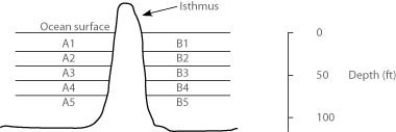A) 2, 3, 1, 4
B) 2, 4, 1, 3
C) 4, 1, 2, 3
D) 4, 2, 1, 3
F) A) and C)
Correct Answer

verified
Correct Answer
verified
Multiple Choice
Use the following description to answer the question. On the volcanic, equatorial West African island of Sao Tomé, two species of fruit fly exist. Drosophila yakuba inhabits the island's lowlands and is also found on the African mainland, located about two hundred miles away. At higher elevations, and only on Sao Tomé, is found the very closely related Drosophila santomea. The two species can hybridize, though male hybrids are sterile. A hybrid zone exists at middle elevations, though hybrids there are greatly outnumbered by D. santomea. Studies of the two species' nuclear genomes reveal that D. yakuba on the island is more closely related to mainland D. yakuba than to D. santomea (2n = 4 in both species) . Sao Tomé rose from the Atlantic Ocean about 14 million years ago. Using only the information provided in the paragraph, which of the following is the best initial hypothesis for how D. santomea descended from D. yakuba?
A) allopolyploidy
B) autopolyploidy
C) habitat differentiation
D) sexual selection
F) All of the above
Correct Answer

verified
Correct Answer
verified
Multiple Choice
The phenomenon of fusion is likely to occur when, after a period of geographic isolation, two populations meet again and ________.
A) an increasing number of infertile hybrids is produced over the course of the next 100 generations
B) no reproduction occurs in the hybrid zone
C) an increasing number of viable, fertile hybrids is produced over the course of the next 100 generations
D) a decreasing number of viable, fertile hybrids is produced over the course of the next 100 generations
F) None of the above
Correct Answer

verified
Correct Answer
verified
Multiple Choice
Suppose that a group of male pied flycatchers migrated from a region where there were no collared flycatchers to a region where both species were present. Assuming events like this are very rare, which of the following scenarios is least likely?
A) Migrant pied males would produce fewer offspring than would resident pied males.
B) Pied females would rarely mate with collared males.
C) Migrant males would mate with collared females more often than with pied females.
D) The frequency of hybrid offspring would decrease.
F) A) and B)
Correct Answer

verified
Correct Answer
verified
Multiple Choice
The difference between geographic isolation and habitat differentiation (isolation) is the ________.
A) relative location of two populations as speciation occurs
B) speed (tempo) at which two populations undergo speciation
C) amount of genetic variation that occurs among two gene pools as speciation occurs
D) identity of the kingdom or domain in which these phenomena occur
F) A) and C)
Correct Answer

verified
Correct Answer
verified
Multiple Choice
In the oceans on either side of the Isthmus of Panama are 30 species of snapping shrimp; some are shallow-water species, others are adapted to deep water. There are 15 species on the Pacific side and 15 different species on the Atlantic side. The Isthmus of Panama started rising about 10 million years ago. The oceans were completely separated by the isthmus about 3 million years ago.
In the figure, the isthmus separates the Pacific Ocean on the left (side A) from the Atlantic Ocean on the right (side B) . The seawater on either side of the isthmus is separated into five depth habitats (1-5) , with 1 being the shallowest.
 The Panama Canal was completed in 1914, and its depth is about 50 feet. After 1914, snapping shrimp species from which habitats should be most likely to form hybrids as the result of the canal?
The Panama Canal was completed in 1914, and its depth is about 50 feet. After 1914, snapping shrimp species from which habitats should be most likely to form hybrids as the result of the canal?
A) A5 and B5
B) A3 and B3
C) A1 and B1
D) A1-A3 and B1-B3 have equal likelihoods of harboring snapping shrimp species that can hybridize.
F) B) and D)
Correct Answer

verified
Correct Answer
verified
Multiple Choice
Rocky Mountain juniper (Juniperus scopulorum) and one-seeded juniper (J. monosperma) have overlapping ranges. Pollen grains (which contain sperm cells) from one species are unable to germinate and make pollen tubes on female ovules (which contain egg cells) of the other species. These two juniper species are kept separate by ________.
A) habitat isolation
B) temporal isolation
C) gametic isolation
D) behavioral isolation
F) A) and B)
Correct Answer

verified
Correct Answer
verified
Showing 61 - 67 of 67
Related Exams